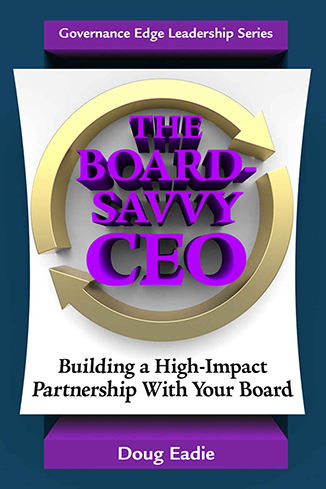Retreats have become a popular vehicle for involving nonprofit board members, their CEOs, and executives in accomplishing high-impact governing work that could not be accomplished – at least not as well – in regular board business meetings. Updating a vision statement and identifying and discussing strategic and operational issues certainly fall in this category. The return on your nonprofit’s investment of time, energy, and money in a retreat can be quite powerful, in terms not only of substantive outcomes such as an updated vision statement, but also process spin-offs such as esprit de corps, satisfaction, ownership of – and commitment to – directions coming out of the retreat, and even emotional bonding among participants.
However, just because you assemble the right cast of characters in an attractive retreat setting away from headquarters for a day or two does not mean that you will automatically realize a powerful return on your investment in the event. Over the years, experience has taught me that rigorously following 4 golden rules will ensure that your retreat pays off handsomely for your nonprofit without taking a significant risk:
- Make sure that your board is involved in putting together the detailed retreat design.
- Employ a professional facilitator.
- Use well-designed breakout groups to generate content, promote feelings of ownership, and generate active participation.
- Avoid reaching premature formal consensus or making final decisions.
Many nonprofits have taken the tack of creating an “ad hoc retreat design committee” to ensure board member involvement in fashioning a detailed retreat design: the specific objectives to be achieved (e.g., the identification of strategic issues); the structure of the retreat (e.g., duration; attendance; whether to use breakout groups and, if so, what groups to employ); and the blow-by-blow agenda. Typically headed by the board chair and including the CEO and 2 to 3 other board members, the ad hoc committee works closely with the retreat facilitator, who after interviewing committee members and reviewing pertinent documentation (such as last year’s retreat report), recommends the key design elements.
The ad hoc committee usually meets only once, either face-to-face or via teleconference, to review and approve the facilitator’s design recommendations, putting in place a detailed retreat “architecture” that is intended to ensure success and to lower the risk of the event’s falling apart to virtually zero. In addition to providing input in generating the detailed retreat design, such ad hoc committees have proved to be a useful vehicle for building board member ownership of the retreat, creating, in effect, an influential group of champions for the event who have had an opportunity to bond with the facilitator.
In my experience, a professional facilitator can make 3 important contributions to the success of your nonprofit’s retreat: (1) bringing experience of what works and doesn’t work to the design process (e.g., how to structure a vision exercise or particular breakout groups); (2) keeping participants on track, ensuring that the retreat objectives are achieved fully within the time allotted in the design; and (3) assisting in the follow-through process, most importantly producing the follow-up action report. Just imagine 11 headstrong board members, the CEO, and several executives spending a whole day or two together discussing highly complex issues on which there are diverse viewpoints, and you can easily see why self-facilitation would be a risky course of action.
Well-designed breakout groups can make a powerful contribution to the success of your retreat. For example, I recently participated in a retreat involving 9 breakout groups – 3 meeting concurrently in each of 3 rounds over the course of 1 ½ days (in round 1, for example, the 3 groups were values/vision; conditions/trends; and strengths/weakness assessment). Breaking participants into smaller groups is not only a sure-fire way to foster active participation and, consequently feelings of ownership, it is also a proven vehicle for generating lots of content. In my experience, the following two steps will help to ensure that the breakout group process is both productive and satisfying:
- Assign board members to lead breakout groups, thereby providing them with ego satisfaction and turning them into strong champions in following through on the retreat. A different board member should lead each group in order to widen board ownership.
- Make sure that the breakout group leaders are well prepared to play their leadership role. You certainly would not want one or more of your colleagues on the board to suffer public embarrassment from fumbling the leader’s job in front of board and executive team colleagues. Keep in mind that some of the board members being tapped for the leader’s role might never have facilitated a breakout group – or at least the particular ones they will be leading, meaning that they will need orientation and training to ensure their success.
Nonprofit board members, CEOs, and senior managers naturally tend to like closure and to get pretty uncomfortable when lots of loose ends are left dangling. So every ad hoc retreat design group I have worked with over the years has included at least one board member who argues passionately for a retreat design that results in formal consensus on particular products such as a vision statement or a list of strategic issues. I always strongly counsel against giving in to this natural appetite for certainty because of the harm premature formal consensus, much less firm decision making, can cause. Think about it for a minute. You and your colleagues are spending a relatively brief time together grappling with very complex matters affecting the long-term success of your nonprofit that defy easy understanding, and you are very unlikely to have on hand the information you need to make definitive judgments. Does it really make sense, under the circumstances, to demand closure? And, anyway, it’s easy enough to put a follow-up process in place that, subsequent to the retreat, gets firm priorities set and final decisions made.






